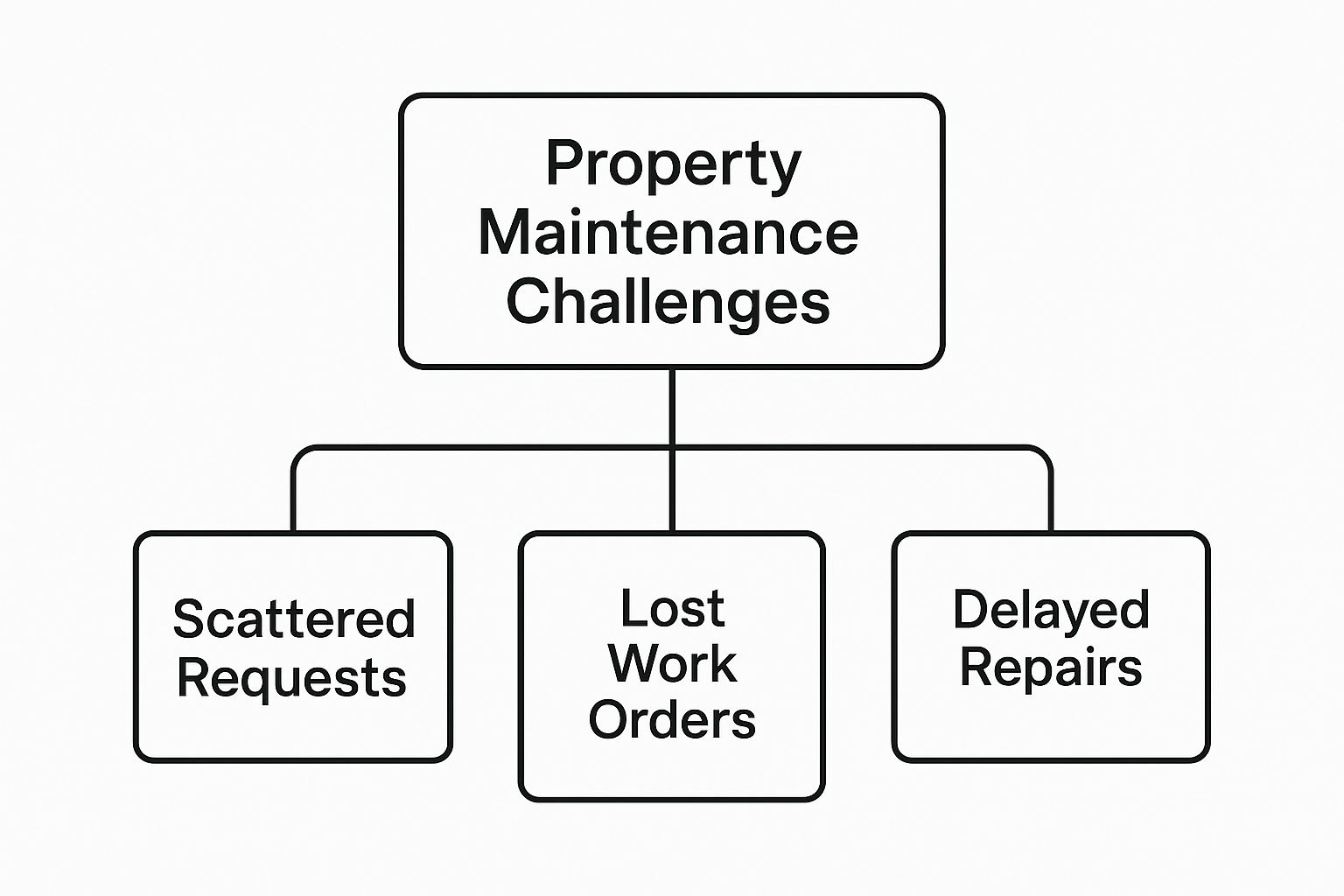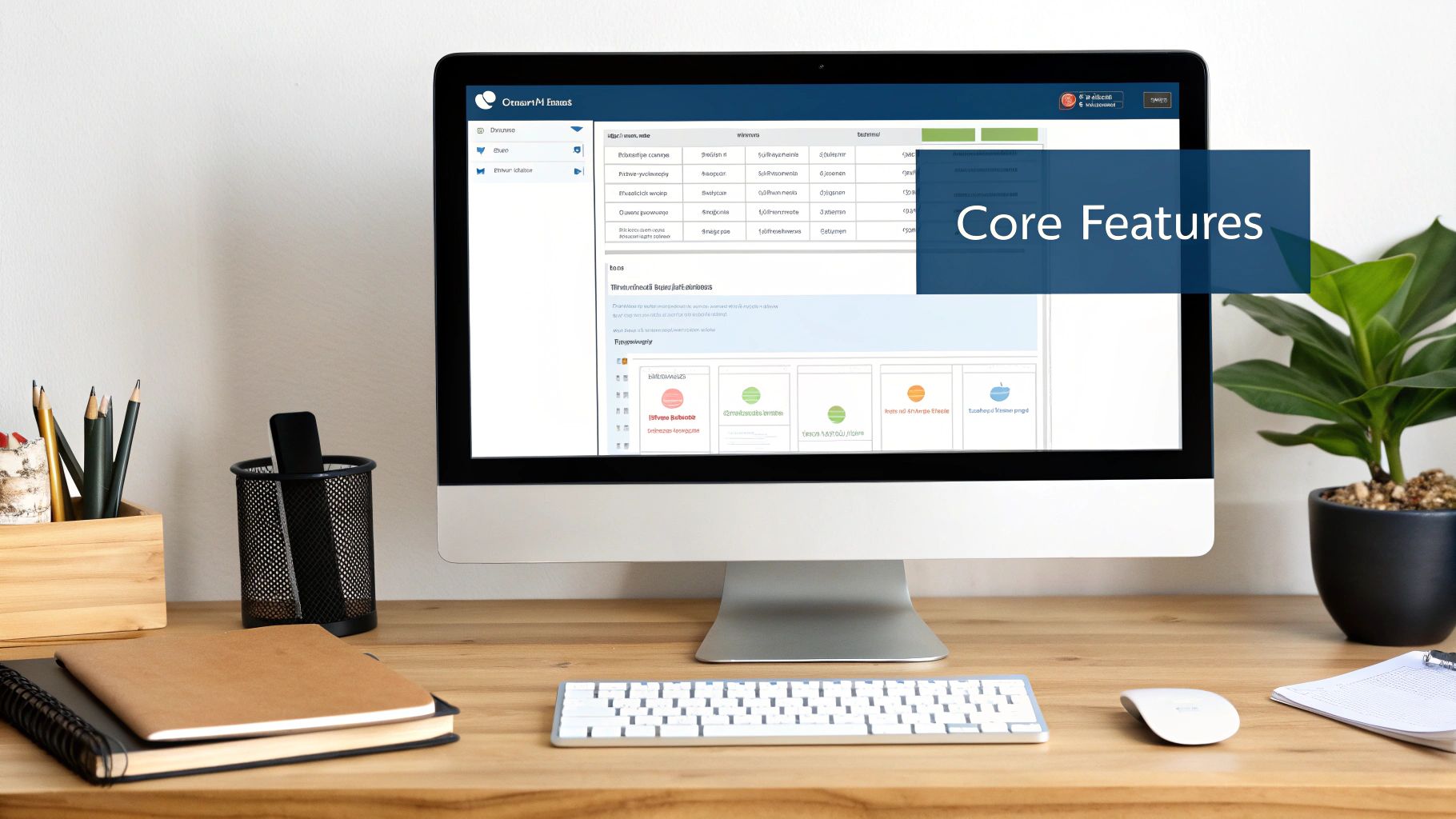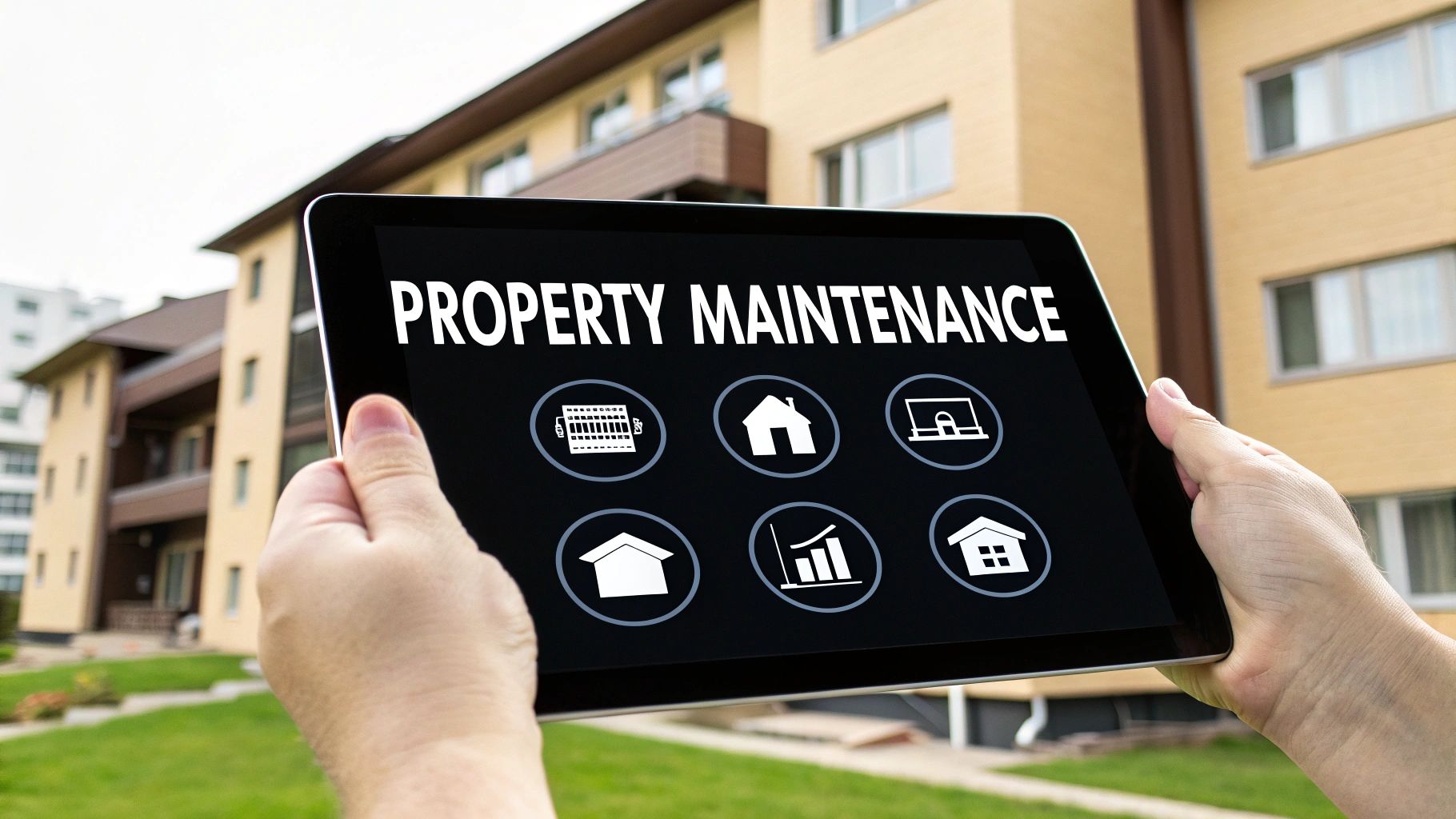If you've ever managed a property, you know the maintenance chaos. A text about a leaky faucet here, a sticky note for a broken lock there, and an invoice from a vendor buried in a mountain of emails. It’s like trying to run a five-star restaurant using only a flip phone and a notepad. Things get missed, and when things get missed, tenants get unhappy and costs spiral out of control.
What Is Property Management Maintenance Software?
Think of this software as the central nervous system for your property's upkeep. It takes all those scattered, chaotic pieces—tenant requests, work orders, vendor communication, invoicing—and pulls them into one clean, organized hub. Instead of reacting to problems as they pop up (and often too late), you get a system that helps you manage everything proactively.
It’s the difference between juggling flaming torches and conducting a symphony. This technology provides a single, reliable source for every maintenance task, from the moment a tenant reports an issue to the final sign-off.
This infographic really hits home on the core challenges that come with sticking to the old, manual ways of handling maintenance.

As you can see, the problems feed on each other. A lost work order leads to a delayed repair, which leads to a frustrated tenant submitting yet another request. It’s a vicious cycle of inefficiency.
Solving the Core Problems of Property Upkeep
At its core, this software is built to break that cycle. It introduces a clear, traceable workflow that brings structure and sanity to the entire process for property managers, tenants, and outside vendors alike. The industry is catching on fast, and the shift toward these tools is undeniable.
The numbers don't lie. The global property management software market is projected to skyrocket from USD 27.95 billion in 2025 to a staggering USD 54.16 billion by 2032. This isn't just a trend; it's a fundamental change driven by the need for smarter operational control. You can dive deeper into this market growth with research from Coherent Market Insights.
Ultimately, this software is all about communication and accountability. It’s designed to make sure a tenant’s request is not just heard, but is also assigned, tracked, and resolved transparently and on time.
By bringing every step of the maintenance journey into one place, these platforms let you:
- Log and Track Requests: Tenants get a simple portal to submit maintenance issues. This instantly creates a digital ticket with all the key details, so nothing gets lost in translation.
- Assign and Dispatch Technicians: Managers can easily assign jobs to their in-house team or trusted external vendors. Technicians receive an alert on their phone with everything they need to know.
- Monitor Progress and Completion: Everyone involved can see the real-time status of a repair. No more back-and-forth calls or "just checking in" emails.
In the end, property management maintenance software helps you shift from constantly putting out fires to actually preventing them. That means a smoother, more predictable, and far more profitable operation.
The Key Features That Make Maintenance Software Work
Think of property management maintenance software less like a single tool and more like a technician's well-organized truck. It’s filled with specific instruments, each designed for a particular job. When they all work together, they create a powerful system that keeps your properties running smoothly. Getting to know these core components is the first step to truly mastering your maintenance operations.
The global property management software market was valued at USD 2.69 billion in 2024 and is expected to hit USD 4.0 billion by 2033. This isn't just growth; it's a fundamental shift driven by features that were once considered futuristic, like mobile apps for technicians and AI that helps schedule jobs. You can get a better sense of this trend from research by the IMARC Group.
This snapshot from Upkeep gives a great visual of how these different features come together.

You can see how a central dashboard pulls in information from work orders, assets, and reporting to give you a complete, at-a-glance view of everything that’s happening.
Not all software is created equal, of course. Some platforms stick to the basics, while others are packed with advanced tools. Here’s a quick breakdown of what you can expect.
Essential vs Advanced Maintenance Software Features
| Feature Category | Essential Functionality (Must-Have) | Advanced Functionality (Nice-to-Have) |
|---|---|---|
| Work Orders | Create, assign, and track maintenance requests. Mobile access for technicians. | AI-powered assignment, automated status updates, multi-language support. |
| Preventive Maintenance | Schedule recurring tasks (e.g., HVAC service) based on time. | Condition-based triggers (e.g., from IoT sensors), predictive failure analysis. |
| Vendor Management | Store vendor contact info, track insurance/license expiration dates. | Vendor performance ratings, automated invoice processing, compliance dashboards. |
| Asset Tracking | Log key property assets (appliances, HVAC units) and their basic info. | Full asset lifecycle tracking, depreciation calculation, warranty management. |
| Reporting | Generate basic reports on work order volume, costs, and completion times. | Customizable dashboards, KPI tracking, and business intelligence integrations. |
Ultimately, the right feature set depends on the size of your portfolio and the complexity of your operations. A single-family home manager might only need the essentials, whereas a large multifamily operator will get immense value from the advanced capabilities.
Work Order Management: The System’s Central Hub
If there’s one feature that’s the absolute heart of any maintenance system, it’s work order management. This is what turns a frantic call from a tenant about a leaky faucet into a neat, trackable digital ticket. It’s the engine that captures, assigns, and follows every single request from the moment it comes in until the job is done.
Many of the best platforms build their workflow around robust help desk ticketing systems, ensuring every single issue is properly logged and never falls through the cracks. To get a better handle on this, our guide on choosing a https://clouddle.com/blog/work-order-management-system/ is a great place to start.
Here’s how it typically plays out:
- Request Comes In: A tenant submits an issue through an online portal, maybe even attaching a photo of the problem.
- It's Logged Automatically: The system instantly generates a new work order with a unique ID, timestamp, and priority level.
- Assign and Dispatch: You can assign the ticket to one of your in-house techs or a trusted vendor. They get an alert right on their phone.
- Everyone Stays in the Loop: From "assigned" to "in progress" and finally "completed," the status is visible to you, the tech, and even the tenant.
This structured approach ends the chaos of sticky notes, missed calls, and confusing email chains. It provides a crystal-clear audit trail for every single job.
Preventive Maintenance Scheduling: Get Ahead of Problems
Reactive repairs are just part of the job. The real money is saved with proactive, preventive maintenance—and that’s what this module is all about. It lets you get ahead of problems by scheduling all those routine but critical tasks, like changing HVAC filters, testing smoke detectors, or cleaning gutters.
Think of it this way: preventive maintenance is like getting a scheduled oil change for your car. The alternative is waiting for the engine to seize up on the highway. One is a predictable, low-cost task; the other is a chaotic, expensive emergency.
By setting up these jobs to recur automatically, you protect your assets from unnecessary wear and tear, extend their operational life, and sidestep those costly, late-night emergency calls.
Vendor Management and Compliance: Your Digital Rolodex
Working with outside contractors is a necessity, but it comes with its own set of headaches. This module acts as your central command center for every vendor you use. It’s where you keep track of all the critical details—think insurance certificates, professional licenses, and signed service agreements.
This isn't just about having contact information in one place. It’s a risk management tool. It ensures you’re only sending properly insured and qualified professionals onto your properties, dramatically reducing your liability.
Good vendor management modules often tie directly into your accounting, letting you approve invoices and track expenses for specific jobs or properties. This gives you a much clearer financial picture of your maintenance spending and makes onboarding new vendors a breeze.
The Real-World Impact of Automation

The true value of property management maintenance software isn't just about a slick list of features. It’s what happens on the ground—in the moments that save you real money, precious time, and a whole lot of stress. Automation fundamentally changes your maintenance workflow, moving you from a constant state of putting out fires to a model of proactive control. It creates a clear "before and after" picture for your business.
Think about it. Instead of getting a frantic call about a burst pipe on a holiday weekend, imagine a system that flagged that very water heater for a routine check-up months ago. That’s the core of what this software does. It transforms unpredictable, high-cost emergencies into scheduled, budget-friendly tasks.
This shift has an immediate effect on your bottom line. Getting ahead of problems stops small issues from spiraling into catastrophic failures, which protects your assets and cuts down on expensive, last-minute repairs. The end game? A maintenance budget you can actually count on.
Boosting Tenant Satisfaction and Retention
Good communication is everything when it comes to keeping tenants happy, and this is where automation really comes into its own. When a resident logs a maintenance request, it doesn't just disappear into a black hole. They get an instant confirmation, can track the work order's status, and receive a notification the moment the job is done.
That kind of transparency builds trust and makes tenants feel valued. They know their problems are being handled, which is a massive factor when it's time to renew their lease. In fact, study after study shows that a landlord's responsiveness to maintenance is one of the biggest drivers of tenant satisfaction.
A happy tenant is far more likely to become a long-term resident. By automating communication and ensuring faster resolutions, you directly contribute to higher retention rates, which is one of the most powerful levers for increasing profitability.
A centralized system also means no request ever gets lost in a cluttered inbox or on a forgotten sticky note. It creates a single source of truth for every repair, eliminating the "he said, she said" arguments that can ruin a good tenant relationship. Trying to achieve this level of organization with spreadsheets and emails is a losing battle.
Making Sharper Financial Decisions
This software is more than just a task manager; it’s a powerful financial planning tool. Every work order, invoice, and repair cost is meticulously logged, building a detailed financial history for each of your properties. This data is pure gold for making smart business decisions.
With just a few clicks, you can suddenly do things like:
- Forecast Budgets with Confidence: Look at spending trends from the past year to build a much more accurate maintenance budget for the next one.
- Plan for Capital Upgrades: Easily spot which assets—like that old roof or the constantly failing HVAC unit—are becoming money pits, helping you decide when it's time to replace versus repair.
- Negotiate Better Vendor Deals: Walk into negotiations armed with hard data on your work volume and costs to get more favorable rates from your contractors.
This data-driven approach takes the guesswork out of managing your properties. You can justify expenses to owners with cold, hard facts and plan for major projects with a clear head. Ultimately, property management maintenance software doesn't just manage tasks—it gives you the business intelligence you need to run a more profitable and stable portfolio.
How to Choose the Right Software for Your Portfolio

Picking the right property management maintenance software can be overwhelming. You're bombarded with feature lists and sales pitches, making it easy to get lost. The secret? Start with your actual problems, not the product's promises. Don't get distracted by shiny objects; focus on what will solve your biggest operational headaches today.
Think of it like this: you wouldn't buy a semi-truck for a quick trip to the grocery store. Before you even look at a demo, grab a notepad and list your top three to five maintenance pain points. Are work orders getting lost in email chains? Is vendor communication a constant back-and-forth? Do you struggle to keep track of recurring tasks? This simple "pain-point first" approach will be your North Star, guiding you to a tool that offers real, immediate value.
Evaluate Scalability for Future Growth
The software that works perfectly for your five-unit portfolio might become a bottleneck by the time you hit fifty units. That’s why scalability is critical. You need to ask potential vendors how their platform handles growth. Does their pricing model penalize you for adding more properties, or does it offer flexible tiers that grow with you?
A system built for growth should manage a bigger load of work orders, users, and properties without slowing down. You’re looking for a long-term partner, not a starter tool you'll have to replace in a year or two.
Prioritize Integration and User Experience
Your maintenance software has to play well with others. It can't be a silo. The most important connection is usually with your accounting platform. If your team has to manually enter data between two systems, you're just inviting errors and wasting hours. Look for platforms that offer seamless integrations with the accounting software you already use.
The user experience is just as crucial. If your technicians find the mobile app clunky and confusing, they won't use it. Plain and simple. That makes your entire investment pointless. A clean, intuitive interface for everyone on your team isn't a "nice-to-have"—it's a must-have for adoption.
A powerful tool that no one uses is worthless. The best property management maintenance software is one that feels easy and logical for everyone involved, from the property manager in the office to the technician in the field.
The market for these platforms is booming. In the U.S. alone, the property management software market is expected to jump from USD 6.0 billion in 2025 to USD 9.5 billion by 2030. While this boom means more choices, it also underscores the importance of solid security to protect against data breaches. You can learn more about these market trends and security considerations here.
Align Features with Your Specific Goals
Once you've identified your pain points and confirmed a platform can scale, then you can start digging into the features. Use that initial list of problems as your filter.
-
Problem: Communication is scattered, and requests get lost.
-
Solution: You need a platform with a centralized tenant portal and a solid mobile app for technicians.
-
Problem: You keep forgetting to schedule routine HVAC services.
-
Solution: Look for a system with a strong preventive maintenance scheduling module.
When you match features directly to your needs, you ensure you’re paying for solutions, not just software. For a side-by-side look at different options, our in-depth property management software comparison guide can help. This focused approach will help you land on a tool that’s truly the right fit for your unique portfolio.
Calculating the ROI of Your Software Investment
https://www.youtube.com/embed/O-wq-C-52NY
So, how do you justify the cost of new technology? It all comes down to the return on investment (ROI), and with property management maintenance software, the real numbers go way beyond the monthly price tag. The true value comes from a mix of direct cost savings and powerful, long-term gains that quietly boost your bottom line.
Think of it like swapping out an old, clunky HVAC unit for a modern, high-efficiency model. You see the upfront cost immediately, but the real win is in the lower energy bills and fewer emergency repair calls month after month. This software is no different—it creates efficiencies that put real money back into your pocket.
Direct Cost Savings and Hard Numbers
The easiest way to see the return is by looking at the direct, tangible savings. These are the figures you can circle on a spreadsheet.
Right away, you'll start to see a difference in a few key areas:
- Slashed Labor Hours: Automation takes over the soul-crushing administrative tasks, freeing up your team for more important work. A work order that used to take an hour to coordinate and follow up on might now get done in just a few clicks.
- Fewer Emergency Calls: This is a big one. Proactive maintenance helps you spot small problems before they explode into expensive, after-hours disasters. That means far fewer frantic calls to plumbers at 2 AM and the premium invoices that come with them.
- Better Vendor Spending: When you have clear data on who’s doing good work, on time and on budget, you’re in a much better position to negotiate. You can ensure you're getting the best value on every single job.
The most compelling argument you can make for new software is one backed by data. When you can show exactly how much you're saving, the tool stops being an expense and starts being an asset.
Indirect Returns That Boost Portfolio Value
Beyond the easy-to-track numbers, the software generates value that's a bit harder to quantify but just as critical for long-term success. These are the benefits that lead to a healthier, more profitable portfolio.
A smooth, transparent maintenance process, for instance, leads to faster response times and happier tenants. And as every property manager knows, happy tenants are far more likely to renew their leases. That higher retention directly reduces the high costs associated with turnover, like lost rent during vacancies, marketing, and make-ready expenses.
On top of that, a property with a meticulous, well-documented maintenance history is simply worth more. The software creates a detailed digital logbook of every repair and every service, which is gold to potential buyers or lenders. It’s proof that you’ve protected the asset.
The ROI Calculation Framework
To help put some numbers to these concepts, here’s a simplified framework. Think of this as a starting point to build your own business case for adopting a dedicated maintenance platform.
| ROI Factor | Cost Saving / Revenue Gain Metric | Example Calculation |
|---|---|---|
| Reduced Labor Costs | Time saved on admin tasks per work order x staff hourly rate x # of work orders per month. | 0.5 hours saved x $25/hour x 100 work orders = $1,250/month |
| Lower Repair Costs | Percentage reduction in emergency call-outs x average emergency repair cost. | 25% reduction x $600 average cost x 5 fewer calls = $750/month |
| Increased Tenant Retention | Reduction in turnover rate x cost of one vacant unit (lost rent + make-ready costs). | 10% turnover reduction x $2,500 cost per turnover / 12 months = $208/month (per unit saved) |
| Vendor Negotiation Savings | Percentage savings negotiated on vendor contracts due to better data and performance tracking. | 5% savings on a $10,000 monthly vendor spend = $500/month |
By adding up just a few of these factors, you can quickly see how the savings can dwarf the monthly subscription fee. When you combine the direct and indirect benefits, investing in property management maintenance software isn't just a smart move—it’s a strategic advantage.
Future Trends in Property Maintenance Technology
The world of property maintenance is changing fast, and it’s about a lot more than just logging work orders. The next wave of property management maintenance software is smarter, more predictive, and woven directly into the fabric of your buildings. We're heading toward a future where our properties practically take care of themselves.
Leading the charge is predictive maintenance. Think about this: what if your HVAC unit could analyze its own performance and tell you a key part is going to fail next month? That's the power of artificial intelligence and machine learning in action. It flips the script from reactive, costly repairs to planned, proactive fixes that save a ton of money and keep tenants happy.
The Rise of Smart Buildings
This whole proactive mindset is powered by the Internet of Things (IoT). Tiny, affordable sensors are becoming the nervous system of modern properties, keeping an eye on everything in real-time. These little gadgets can spot problems a person would never notice until it's a full-blown emergency.
- Leak Detection: Smart water sensors can fire off an alert about a tiny leak before it becomes a multi-floor flood.
- HVAC Monitoring: Sensors can track filter health and how efficiently the system is running, triggering maintenance based on actual wear and tear, not just a date on the calendar.
- Occupancy Insights: Knowing how and when different parts of a building are used helps you create smarter cleaning schedules and slash energy bills.
The next generation of maintenance technology is all about creating a conversation between the building and its manager. The property itself will tell you what it needs and when.
Augmented reality (AR) is another technology that’s set to make a huge impact. Picture a newer technician wearing an AR headset while a senior expert, miles away, sees what they see. The expert can guide the repair in real-time, pointing things out and overlaying diagrams right in the technician's field of view. This kind of tech means fewer trips, faster fixes, and getting the job done right the first time.
To really get a handle on this, you can learn more about the role of IoT in property management and see how it's building this new reality.
Still Have Questions? Let's Clear Things Up.
Diving into any new technology brings up a lot of "what ifs." It's only natural. Below, I’ve tackled some of the most common questions property managers ask when they're thinking about adding a dedicated maintenance software to their toolkit. The goal is to give you straightforward answers so you can make your next move with confidence.
How Long Does It Take to Get Everything Set Up?
The honest answer? It depends, but you might be surprised how fast it can be. For a smaller portfolio, you could genuinely be up and running in a weekend. The process is often as simple as importing your existing data on properties, tenants, and vendors.
If you’re managing a larger portfolio with more complex needs, the timeline naturally stretches out. Think about moving data from older systems, getting your team trained, and setting up custom workflows to match how you operate. A good software provider will give you a dedicated onboarding specialist to walk you through it, usually aiming to have you fully live within 30 to 60 days.
Will My Vendors and Technicians Actually Use This Thing?
This is probably the most important question you can ask, and the answer comes down to one thing: a killer mobile app. Your field team and third-party vendors live on their phones. They won’t tolerate a clunky, confusing system. The best platforms are designed for people on the go, making it dead simple to get job details, add notes, snap a few photos, and mark work complete in just a couple of taps.
Here’s a pro tip for getting everyone on board: involve them in the selection process. When your lead technician or go-to plumber has a say in the tool they'll use every day, they're much more likely to embrace it. Many modern systems even let vendors participate with a simple text or email link—no account creation required.
Can This Software Talk to My Accounting Program?
Absolutely, and you shouldn't settle for anything less. A maintenance system that doesn't connect with your financial software is a recipe for disaster. It means double data entry, which wastes time and almost guarantees you'll make costly mistakes.
The top-tier property management maintenance software is built from the ground up to play nicely with popular accounting platforms like QuickBooks, Xero, and AppFolio. This integration means approved invoices and work order costs flow right into your books, keeping your financials perfectly accurate without you having to lift a finger.
What's the Difference Between a CMMS and Property Software?
It’s easy to get these two confused, but they're built for very different worlds. A CMMS (Computerized Maintenance Management System) is a heavy-duty tool often used in manufacturing or large facilities to track the lifecycle of physical equipment—think factory machinery or HVAC systems in a massive commercial complex. It’s all about the asset itself.
Property management software, on the other hand, is purpose-built for the rental industry. It certainly has powerful maintenance features, but it also includes all the other critical pieces a CMMS ignores, like tenant communication portals, lease tracking, and rent collection. It’s designed around the entire ecosystem of a rental property, not just the nuts and bolts inside it.
Ready to bring clarity and control to your maintenance operations? The expert team at Clouddle Inc can design an integrated technology solution that streamlines your workflow, from networking to security. Discover how our managed IT services can optimize your properties today!


